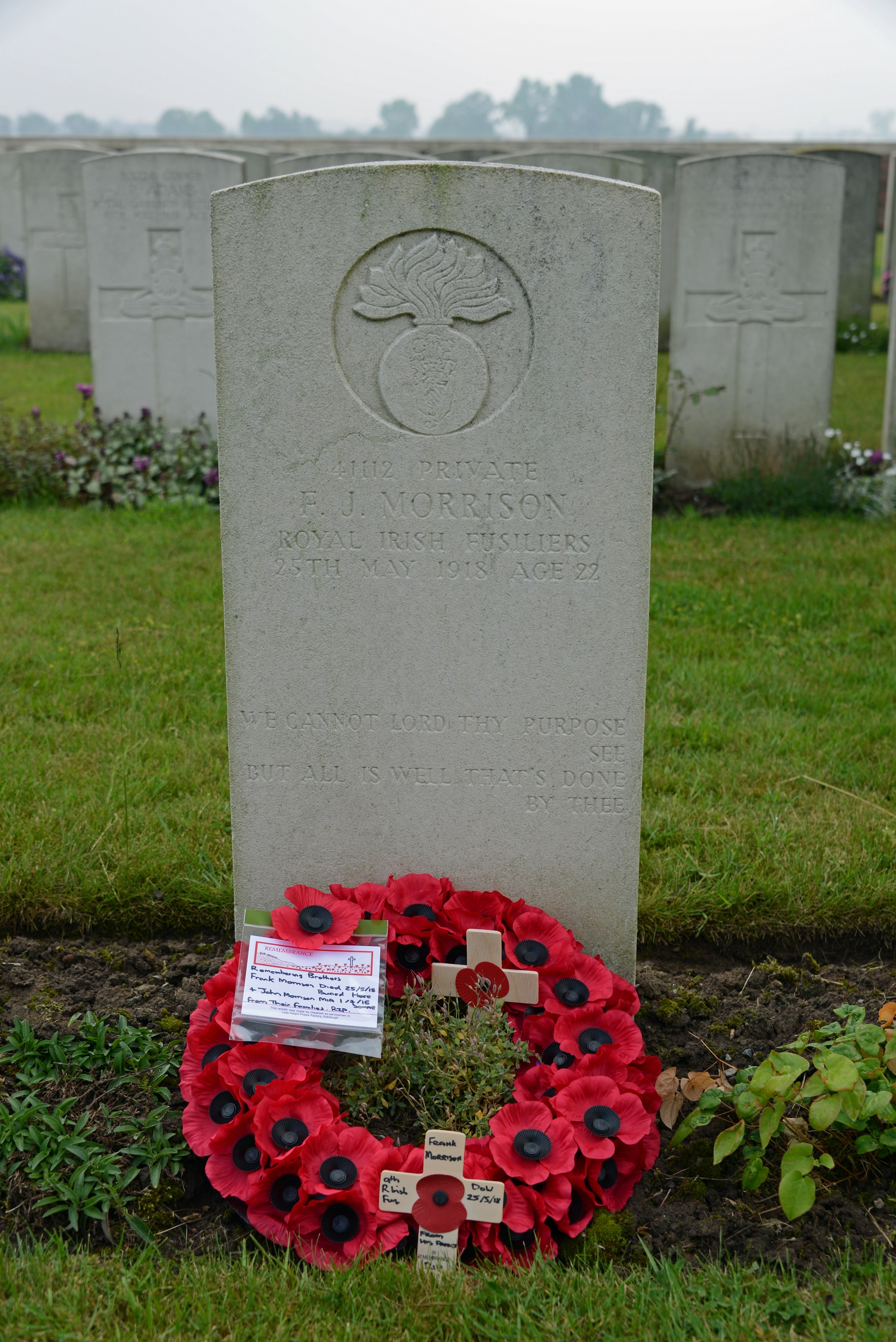
Francis James Morrison, known as Frank to his family, was born on 30th June 1895 at Cornakessagh, Brookeborough, County Fermanagh, the seventh of eleven children of Alexander Morrison, a labourer on the Colebrooke Estate of the Brooke family, and Margaret Morrison (nee Rutherford). He was baptised at the Wesleyan Chapel in Brookeborough on the 14th November 1895.
By the 1901 Census, the family were living at Coolcoghill near Brookeborough and Frank was in education. Ten years later in 1911, Frank was living a few miles away in the townland of Raw and working as a labourer on the farm of Mr. John Kidney.
In 1912, Frank joined the Ulster Volunteers (later the Ulster Volunteer Force), created to oppose Home Rule in Ireland. On the 28th September 1912, he was also a signatory to the Ulster Covenant, a solemn oath by Ulster’s unionists to resist Home Rule.

Frank enlisted in the 6th (Inniskilling) Dragoons Service Squadron at Lisnaskea, County Fermanagh on or about the 7th November 1914, being allocated the service number UD/198.
On the 5th October 1915 he embarked for France sailing with his squadron on board the transport “City of Chester” from Southampton to Le Havre. The squadron was then serving as divisional cavalry to the 36th (Ulster) Division and spent most of the following eight months in the Amiens area, mainly employed on training, drill and general duties.
Frank's first Christmas in France was spent at Famechon, north of Amiens, where he had a taste of home, the squadron war diary noting “a present of plum puddings was received from the ladies and gentlemen of Fermanagh, Ireland”. The routine of exercises, general fatigues and inspections (of men and horses) continued into the New Year.
On the 29th May the Squadron received the news that in the absence of a need for divisional cavalry, it would, with two squadrons of the North Irish Horse (NIH), form a new corps cavalry regiment in X Corps. On 21st June 1916 Frank's Squadron rode from Puchevillers to Toutencourt to join with B and C Squadrons of the NIH and form the 2nd North Irish Horse Regiment, although the Dragoons retained their squadron identity within the new unit.
Through the early days of the Somme battle the new Regiment worked in supporting roles within the 36th (Ulster) Division. However, for a large part of July the Regiment had the unenviable task of retrieving and burying bodies from the battlefield, one of whom may have been Frank’s brother, John, who had been posted missing whilst serving with the 11th Inniskillings on the 1st July.
By the spring of 1917 the 2nd NIH Regiment was supporting X Corps at Ypres but there continued to be little need for front line cavalry. In July 1917, the decision was taken to disband the 2nd NIH Regiment and re-train its men as infantry. After saying farewell to their horses, they set off for training for their new role at the 36th (Ulster) Division Infantry Base Depot at Harfleur.
On the 20th September 1917 Frank was formally transferred to the Royal Irish Fusiliers (with new service number 41112) and posted to the 9th (Service) Battalion, which was then renamed the 9th (North Irish Horse) Battalion, joining it in the field at Ruyaulcourt. It’s likely that Frank saw action with his new unit during the Battle of Cambrai in November and December 1917, during the German offensive at St Quentin from 21st to 28th March 1918, and at Mont Kemmel in April 1918.
On the 19th April the battalion marched away from Kemmel to re-join the rest of the 36th (Ulster) Division near Ypres. On the 17th May it relieved the 12th Royal Irish Rifles in the front line towards St. Julian. A number of fighting patrols were sent out and the battalion lines were also subject to frequent shelling.
It is not known exactly what happened to Frank but it is believed he was hit by shrapnel whilst in the vicinity of Wieltje. The battalion war diary simply records that between entering the line on the 23rd May to leaving on the 29th May, 3 other ranks died of wounds. Frank was evacuated to the main dressing station (MDS) at Gwalia Farm near Poperinghe. He died there of his wounds on 25th May 1918, just a month short of his 23rd birthday.
Frank is interred at Gwalia War Cemetery (grave 11.C.29). Lying just two graves away, and from the same battalion, is Private William Withers of Milford, County Armagh, who died on the 27th May. The death from wounds of both men was confirmed in the War Office Daily Casualty List of the 29th June 1916 – the only members of the Battalion listed on that date.
Frank is also commemorated on the war memorials in both Enniskillen and Brookeborough.
Frank was awarded the 1914-15 Star, the British War Medal and the Victory Medal


